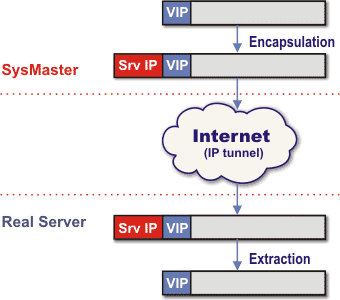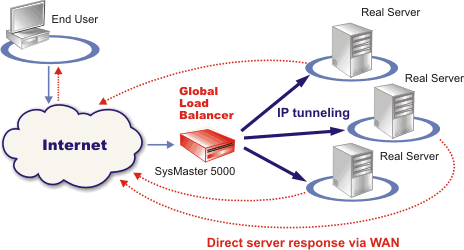|
Global IP Tunneling is the feature that allows
SysMaster to loadbalance servers situated in different physical
locations and in this way to implement global traffic management
solutions.
How It Works?
Global IP Tunneling uses IP encapsulation to allow
datagrams for one IP address to be wrapped and directed to another
IP address. There, the original datagrams are extracted and processed
locally. The process can be illustrated with the following figure:

When a client sends a request to a service managed by SysMaster,
the request packet arrives at SysMaster. The device checks the destination
IP and port number of the packet and if they are recognized as the
address of one of SysMaster's services, a real server that will
process this request is assigned according to the configured loadbalancing
technique. SysMaster adds a record for this new connection into
its hash table. SysMaster encapsulates the packet within an IP datagram
and forwards it to the chosen server. All subsequent packets for
this connection will be again encapsulated and forwarded to the
same real server as long as the connection record exists in the
hash table. When the server receives the packet, it extracts the
original packet from the datagram. If it finds that there is an
interface that can take the packet, the server processes the request
locally. The result of the request is sent directly to the client
according to the routing table of the real server. When the connection
terminates or expires, its record is removed from the hash table.

Quick Responses to Client Requests
As you can see with the Global IP Tunneling method,
SysMaster like the Direct Path Routing technique processes only
the incoming traffic and the outgoing traffic is sent directly to
the clients. The difference with the Direct Path Routing technique
is that real servers can have any real IP address in any network.
They can be geographically distributed around the world.
There is a requirement for the operating systems of the real servers
to support the IP encapsulation protocol. Their tunnel devices are
all configured up so that the systems can extract the encapsulated
packets properly.
Global Load Balancing
SysMaster Global IP tunneling feature can be used
to build a very high-performance and high reliability solution.
As real servers are distributed among different physical locations,
clients will be serviced uninterruptedly even if a site-wide failure
occurs.
|





